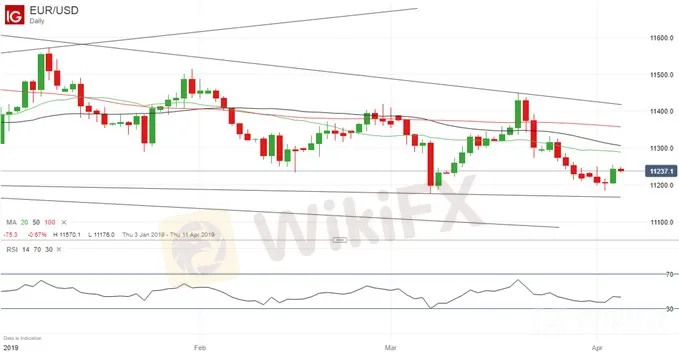简体中文
繁體中文
English
Pусский
日本語
ภาษาไทย
Tiếng Việt
Bahasa Indonesia
Español
हिन्दी
Filippiiniläinen
Français
Deutsch
Português
Türkçe
한국어
العربية
German Manufacturing Slump Long-Term Negative for Euro
Abstract:A tumble in German industrial orders in February suggests the Eurozones largest economy is struggling, and that could have a detrimental impact on the Euro in the months ahead.
German manufacturing and the Euro:
German industrial orders fell by 4.2% month/month in February after a revised 2.1% drop in January.
That suggests industrial output data due Friday may also be weak, and the poor state of the German economy will likely put long-term downward pressure on the Euro.
German factory orders tumble
German industrial orders dropped by 4.2% month/month in February, better than the 4.5% fall predicted by economists but worse than the revised 2.1% decrease in January. Combined with Mondays news that the IHS Markit/BME German manufacturing PMI dropped sharply in March to 44.1 from 47.6 in February, the data suggest that industrial output figures for February, due Friday, will also show economic weakness.
Monday‘s purchasing managers’ index for the German manufacturing sector fell to its lowest since July 2012, with new orders posting their steepest drop since April 2009 and employment easing for the first time in three years.
Wednesdays services PMI was much more positive but the composite output index for the German economy as a whole was still the lowest for nearly six years, pointing to only modest underlying economic growth.
This is all likely to be ignored by Euro traders near-term but will likely have a negative effect on the currency in the months ahead as the European Central Bank continues to postpone any tightening of Eurozone monetary policy.
EURUSD Price Chart, Daily Timeframe (Year-to-date)

Chart by IG (You can click on it for a larger image)
Meanwhile, yields on German government debt remain negative all the way out to nine years, with the yield on the benchmark 10-year Bund barely positive at 0.003% – a factor that could deter foreign investors from buying the Euro.
Disclaimer:
The views in this article only represent the author's personal views, and do not constitute investment advice on this platform. This platform does not guarantee the accuracy, completeness and timeliness of the information in the article, and will not be liable for any loss caused by the use of or reliance on the information in the article.
Read more

KVB Market Analysis | 23 August: JPY Gains Ground Against USD as BoJ Signals Possible Rate Hike
JPY strengthened against the USD, pushing USD/JPY near 145.00, driven by strong inflation data and BoJ rate hike expectations. Japan's strong Q2 GDP growth added support. However, USD gains may be limited by expectations of a Fed rate cut in September.

KVB Market Analysis | 22 August: Gold Stays Strong Above $2,500 as Fed Rate Cut Hints Loom
Gold prices remain above $2,500, near record highs, as investors await the Federal Open Market Committee minutes for confirmation of a potential Fed rate cut in September. The Fed's dovish shift, prioritizing employment over inflation, has weakened the US Dollar, boosting gold. A recent revision showing the US created 818,000 fewer jobs than initially reported also strengthens the case for a rate cut.

KVB Market Analysis | 21 August: USD/JPY Stalls Near 145.50 Amid Diverging Economic Indicators
USD/JPY holds near 145.50, recovering from 144.95 lows. The Yen strengthens on strong GDP, boosting rate hike expectations for the Bank of Japan. However, gains may be limited by potential US Fed rate cuts in September.

KVB Market Analysis | 20 August: Gold Prices Remain Near Record High Amid US Rate Cut Expectations
Gold prices remain near record highs, driven by expectations of a US interest rate cut and a weakening US Dollar. Investors are focusing on the upcoming Jackson Hole Symposium, where Fed Chair Jerome Powell's speech will be closely watched for clues on the Fed's stance. Additionally, the release of US manufacturing data (PMIs) is expected to influence gold's direction.
WikiFX Broker
Latest News
Justin Sun Invests $30M in Trump-Backed World Liberty Financial
Kraken Closes NFT Marketplace Amid New Product Focus
Robinhood Launches Ethereum Staking with 100% Rewards Match
Broker Review: Is FOREX.com a solid Broker?
Philippine Banks Launch PHPX Stablecoin to Transform Payments
Elon Musk Warns of Imminent US Bankruptcy | Bitcoin Retreats from $100K
WikiEXPO Global Expert Interview: Advanced Practices and Insights in Financial Regulation
Pros & Cons of Automated Forex Trading
Magic Compass Sponsors World Taekwondo Poomsae Championships 2024
Trump tariffs: President-elect is serious but it\s not about trade
Currency Calculator


